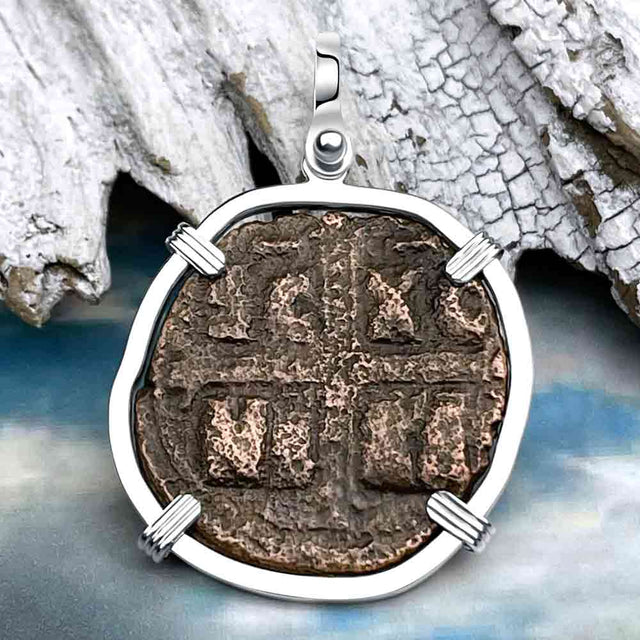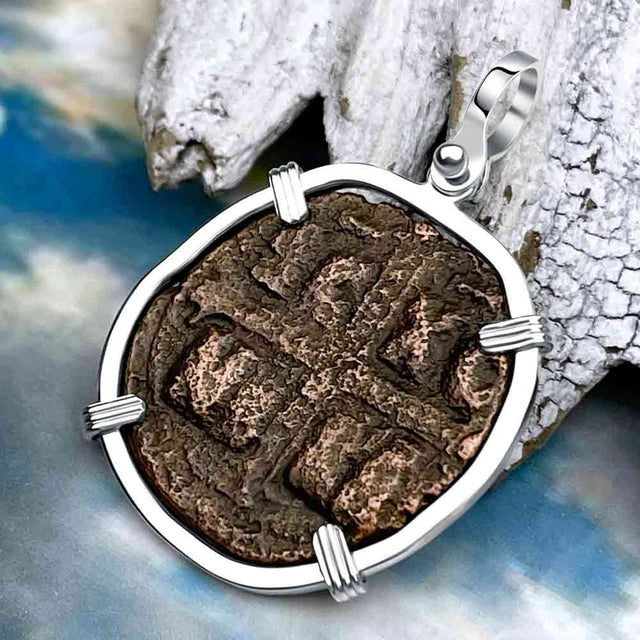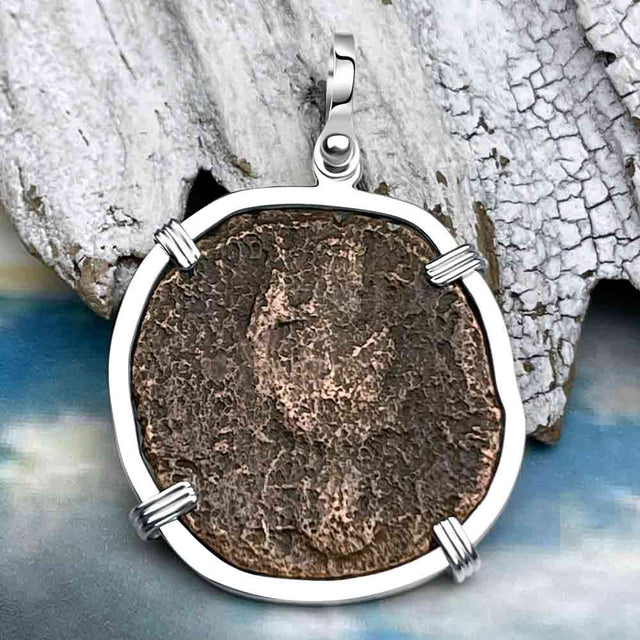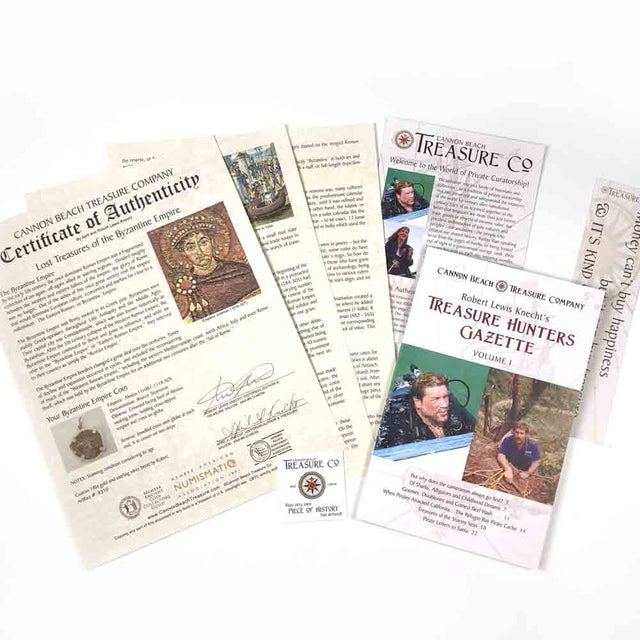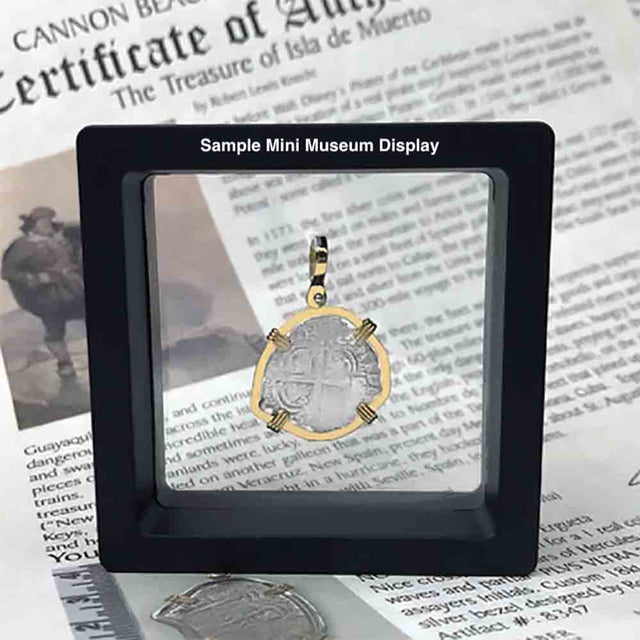Byzantine Bronze Follis Coin - May Jesus Christ Conquer, in a Sterling Silver Pendant | Artifact #6866
Byzantine Bronze Follis Coin - May Jesus Christ Conquer, in a Sterling Silver Pendant | Artifact #6866 is backordered and will ship as soon as it is back in stock.
Couldn't load pickup availability
The Byzantine Bronze Follis: Jesus Christ, King of Kings in an Heirloom Pendant
Please Note: This is an authentic ancient Byzantine Treasure Coin, and you will receive the exact pendant in the photographs and description.
FOR PENDANT SIZE SEE COIN DETAILS BELOW
By the early 5th Century, the once dominant Roman Empire was a fragmented collection of on-again, off-again allied or warring regions. Divided roughly between the western and eastern halves of the empire, the glory of Rome was no longer. Out of the ashes of this once great society rose the empire that would dominate European culture, economics and warfare for close to a millennium: The Eastern Roman, or Christian Byzantine Empire.
It is from this mighty Christian empire, surrounded by non-christian kingdoms, that this regal bronze follis comes. Bearing a portrait of Jesus Christ with the book of the Gospels on the front, on the back is the bold cross.
Your Byzantine Bronze Follis:
- Denomination: Follis
- Date: 1068 - 1071 AD
- Emperor: Romanus IV
- Obverse (Front): Jesus Christ Holding the Gospels in Left Hand and Right Hand Raised in Benediction - to the left and right of Christ: IC XC / NI KA "May Jesus Christ Conquer"
- Reverse (Back): Cross with Greek abbreviations in 4 cross quadrants: I X / N K "May Jesus Christ Conquer"
- Coin Metal: Bronze
- Mint: Constantinople
- Bezel Metal: Proprietary, Non-Tarnishing Sterling Silver
- Articulating Bail Interior Diameter: Will accommodate chain or leather necklace up to 6.2 mm
- Pendant Size including the bezel: 1 1/8” Across, 1 1/2” Tall - almost the width of a 50 cent piece
Robert's Notes: Beautiful cross... this coin certainly has a story to tell. It's hard to believe this coin is about 1,000 years old. It only survived this long by being buried for hundreds of years, then painstakingly conserved in our conservation lab.
Note on the Greek Legend: On the cross side: "IC" are the first letters of Jesus in Greek, and "XC" the first letters of Christ, and in the lower quadrants, "Ni" / "Ka" translates to "May Jesus Christ Conquer." These abbreviations are also usually seen on the front of the coin, appearing to the left and right of Christ.
The Byzantine Empire was firmly rooted in its Greek past. Byzantines were mainly Greek-speakers throughout Late Antiquity and the Middle Ages. Their capital city was Constantinople, which was also known historically as Byzantium. After the 5th century collapse of the Western Roman Empire, the Byzantine Empire continued to thrive and grow in influence, and while we refer to the “Byzantine Empire” or “Eastern Roman Empire,” they referred to their country as simply the “Roman Empire.”
Byzantine money – the money used in the Eastern Roman Empire after the fall of the West (circa 470 AD) – was made up of two very different types of coins: the gold solidus and a variety of bronze coins with clearly defined values. By the end of the empire, coins were issued in silver and bronze only.
Early Byzantine coins are familiar to those who are used to Roman Empire coins. On the obverse, or front, is the bust of the Emperor, with one significant change. Now, the Emperor is portrayed full face rather than in profile. On the reverse, or back, of Byzantine coins is usually a Christian symbol. Crosses and angels (based on the winged Roman goddess Victory) were often used.
By the rule of Emperor Justinian II (685–695), Byzantine coins were becoming more distinctly “Byzantine” in both art and symbolism. Justinian was the first to picture Jesus Christ on the obverse of his coinage, with a half, or full-length depiction of the Emperor on the reverse.
Throughout the centuries, Byzantine coins were a staple of trade throughout Europe and the Orient. These coins are found throughout Europe, the Middle East, the Orient and North Africa to this day. Each is a snapshot into the past, when a once-great empire ruled the Eastern world.
Your Byzantine Follis Pendant comes with:
- Our 100% Authentic Lifetime Guarantee
- A Detailed, Customized, Multi-Page, Full Color Photo Certificate of Authenticity Researched and Written by April Knecht & Robert Lewis Knecht
- Treasure Hunters Gazette Booklet
- Mini Museum Display for when you are not wearing your treasure
- A Treasure Jewelry Care Card
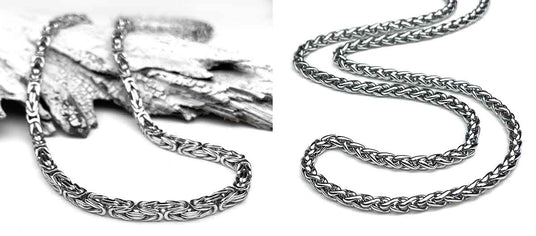
Save 20% on a Chain!
with your treasure coin purchase. Choose your chain and enter Coupon Code: CHAIN at checkout. (Does not apply to discounted clearance chains.)

We're Robert & April and we're here to help!
Questions? Confused? Looking for a gift? We're experts at matching treasure to people. Give us a call at 503.436.1626, join us on Live Chat, or drop us an email at treasure@cannonbeachtreasure.com.

